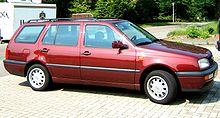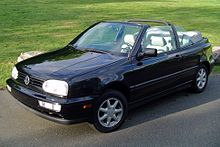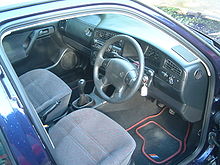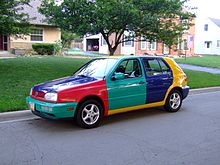- Volkswagen Golf Mk3
-
Volkswagen Golf Mk3 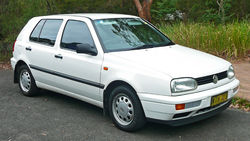
Manufacturer Volkswagen Production 4.8 million units[1]
1991-1999
Cabrio: 1994-2002Assembly Wolfsburg, Germany
Puebla, Mexico
Bratislava, Slovakia
Uitenhage, South Africa.Predecessor Volkswagen Golf Mk2
Volkswagen Golf Cabriolet Mk1 (Cabrio)Successor Volkswagen Golf Mk4
Volkswagen New Beetle convertible (Cabrio)Body style 3-door hatchback
5-door estate
5-door hatchback
2-door convertibleLayout Front engine, front-wheel drive / 4motion four-wheel drive Platform Volkswagen Group A3 platform Engine 1.4 I4 40/44 kW (ABD/AEX/APQ)
1.6 I4 55 kW (ABU/AEA/AEE)
1.6 I4 74 kW (AEK/AFT/AKS)
1.8 I4 55 kW (AAM/ANN)
1.8 I4 66 kW (ABS/ADZ/ACC/ANP)
2.0 I4 85 kW (2E/ADY/AGG/AKR/ABA/AWG/AWF)
2.0 I4 16v 110 kW (ABF)
2.8 VR6 128 kW (AAA)
2.9 VR6 140 kW (ABV)
1.9 I4 D 47 kW (1Y)
1.9 I4 SDI 47 kW (AEY)
1.9 I4 TD 55 kW (AAZ)
1.9 I4 TDI 66 kW (1Z/ALE/AHU)
1.9 I4 TDI 81 kW (AFN/AVG)Transmission 4-speed automatic
4-speed/5-speed manualWheelbase 1992-95: 2,471 mm (97.3 in)
1996-99: 2,474 mm (97.4 in)Length 4,074 mm (160.4 in) Width 1,694 mm (66.7 in) Height 1992-95 & Cabrio: 1,422 mm (56.0 in)
1996-99: 1,428 mm (56.2 in)Related Volkswagen Jetta
Volkswagen VentoThe third-generation Volkswagen Golf Mk3 was a car launched in Europe in November 1991 (though not in the United Kingdom until March 1992),[2] and in North America in the spring of 1993. The delay in North America was due to Volkswagen's decision to supply U.S. and Canadian dealerships with Mk3 Golfs (and A3 Jettas) from the VW plant in Puebla, Mexico. Quality control problems led Volkswagen of America to reject Golfs and Jettas from Mexico; shortly thereafter labor unrest at the plant delayed production there even further. The third-generation Golf and Jetta first appeared in North America as 1993 models in the San Diego, California area and in Canada, then in the autumn in the rest of North America as 1994 models. The Mk3 Cabrio replaced the Volkswagen Cabriolet, which continued the original Golf until 1993, although the original Golf, sold as Rabbit in the United States and Canada ceased sales in 1984. The Mk3 Cabrio continued until the 2002 model year, when Volkswagen replaced it with a convertible version of the Volkswagen New Beetle.
Contents
Naming
.
Models
Three-door Golfs of this generation were mostly only available in North America in GTI form. For the first time, an estate was produced, bringing it into line with key competitors such as the Ford Escort and Vauxhall/Opel Astra which had long been available as estates. The GTI variants included a 2.8L V6 model, the VR6 engine, and a convertible launched as the Cabrio (Typ 1E).
Variant
Cabriolet
The Volkswagen Golf Mk3 Cabrio (or Typ 1E) was introduced in 1993. It was facelifted in late 1999 with the front, rear, and steering wheel styling from the Golf Mk4 while still maintaining the body from the Mk3 Cabrio. These Cabrios are often referred to as the Mk3.5 Cabrios. The Volkswagen Golf Cabrio was discontinued in 2002.
Features
A 16-valve version of the third-generation Golf GTI was introduced in 1993. The engine was enlarged to 2.0 L, with power now reaching 150 PS (110 kW/148 hp). While less powered than the VR6, it was still relatively popular with driving enthusiasts in Europe, because it offered similar power without the thirst or tax burden of a 6 cylinder. As with previous versions the Golf Driver took its place as the official GTI-look-alike but with a single-point injected 1.8 L engine.
The Golf Mk3 was also the predecessor of the "diesel craze" that swept through Europe in the late 1990s and early 2000s, when Volkswagen introduced the direct-injection system with the 90 PS (66 kW; 89 hp) Golf TDI in 1993.
Also offered was a naturally aspirated version of the 1.9 L diesel engine, the SDI, offering 47 kW (64 PS; 63 hp).
The Golf Mk3 was also available in "Ecomatic" form. It was powered with a diesel engine and a clutchless manual transmission. The vehicle would freewheel by opening of the clutch as soon as the accelerator is released, and the engine was switched off after a further 1.5 seconds of inactivity, whether by stopping or coasting. Re-starting the engine simply required depressing the accelerator pedal.[3] VW had previously pioneered similar technology in the VW Polo "Formel E" in the 1980s.
There was also a limited production run of around 250 "CityStromer" vehicles, mainly sold to the German market, which were fully electric vehicles, incorporating 6 batteries in the engine bay, and a further 10 underneath the luggage area. It had a range of approximately 50 km. The vehicle could be filled with a small amount of diesel to provide heat for the cabin.[4]
As had happened with the Mk1 and Mk2, the Mk3 remained available in US for a year after it was discontinued in Europe (1998). The Mk3 continued to be produced for the 1999 model year where it was sold in North and South America. These 1999 Mk3 cars were the last produced in the world and sold alongside the Mk4 in showrooms.
- Awards
- 1997 Which? Magazine best buys: best family car
- European Car of the Year: 1992
- 1992 What Car? car of the year
Mk3 special editions
20th Anniversary GTI
Volkswagen produced a limited quantity of 1000 special-edition 3 and 5-door GTI Anniversary models, celebrating 20 years of the GTI model. This had the usual GTI specification but came equipped with special chequered Recaro front sport seats and matching rear seats bearing the GTI logo, red seat belts front and rear, half-chromed and leather golf ball gear knob, red stitched leather steering wheel and handbrake gaiter. The release knob on the hand brake was also red and silver instrument dials. Floor mats also had red piping along their edges. The red theme continued externally with a red striping on the bumpers and red brake calipers. The wheels were 16" x 7.5" split rim BBS RS 722 alloys, visually similar to the 15" that were found on VR6 model. Brush stainless steel rear twin tailpipes on the exhaust and smoked front fog and indicator lamps to match the rear lamps. 3 optional extras were made available; electric sunroof, air conditioning and metallic black paintwork. Insurance was based on the standard GTI which made this version a very desirable model. The edition was sold in only 6 colour schemes and the 1000 number figures that were produced was as follows; 600 8 valve models, 150 16 valve models and 250 TDI models. The diesel model was only produced for the European market and was not sold in the UK. Unfortunately many of the models fell into the UK company car and lease market prior to the second-hand market and its believed only a few hundred still survive. However, another factor in the rarity of Mark 3 Golfs, unlike the excellent build quality of the Mark 2, at least in the UK, is the very low quality steel sourced by VW, and used across the range, from entry model to VR6. According to independent mechanics and parts specialists, and MOT testers, the floorpan, both door sills, and rear hatch suffer severe rot and disintegration, and anybody planning to buy oneis advised to check for rot, and holes and patches to the floorpan.
Harlequin Edition
Volkswagen originally created the Design series to tour at International Auto shows. Due to the huge public response of the original four Design series, 60 more were produced. Eventually, 264 were made and offered in 1996, exclusively in the North American market.
Based on the 1996 Golf GL platform, the Harlequin model included: limited edition Harlequin paint scheme, limited edition Harlequin sport cloth seats, and silver-faced gauges. They were offered with several different wheel options.
One of the rarest VWs ever produced, the Harlequins were produced by swapping the body panels of four different colored Golfs. They are usually designated by their base color (the color of the car with no body panels attached). The base color is not repeated on any of the other body parts.
Colors Tornado
RedGinster
YellowPistachio
GreenChagall
BlueColor Example Color Code LY3D L132 LD6D L5D5 Color
PatternRed
BaseYellow
BaseGreen
BaseBlue
BaseRoof
Rocker Panel
Rear QuarterFront Bumper
Front Doors
Side MirrorsHood
Rear Doors
Rear BumperFront Fenders
Front GrillRear Hatch Wolfsburg Edition
A Wolfsburg Edition was produced alongside other Mk3 "Wolfsburg Edition" Jettas in the United States. Like the Wolfsburg Edition Jetta, Mk3 Golfs with the Wolfsburg package came standard with an improved white/tan dual-tone interior, smoked tail-lamps, premium alloy wheels, remote entry, power windows/mirrors, and an tilt/slide sunroof. The Wolfsburg Edition was only available with the VW 8-valve SOHC 2.0L engine.
European tour editions
During the 1990s, Volkswagen sponsored three high-profile rock bands' European tours, and issued a special-edition Golf, with distinctive exterior markings, for each: the Golf Pink Floyd Edition (1994), the Golf Rolling Stones Edition (1995), and the Golf Bon Jovi Edition (1996).
European Car of the Year
The Golf MK3 was voted European Car of the Year for 1992 - the first Volkswagen to win this award.[5]
Engine choices
Name Volume Engine Fuel Output Torque Engine code 0–100 km/h,s Top speed Years 1.4 1390 cc 4cyl Petrol 60 PS (44 kW; 59 hp) @5200 rpm 107 N·m (79 lb·ft) @2800−3200 rpm ABD 16.3 157 km/h (98 mph) 1991−1995 1.4 1391 cc 4cyl Petrol 60 PS (44 kW; 59 hp) @4700 rpm 116 N·m (86 lb·ft) @2800−3200 rpm AEX/APQ 15.9 158 km/h (98 mph) 1995−1997 1.6 1598 cc 4cyl Petrol 75 PS (55 kW; 74 hp) @5200 rpm 125 N·m (92 lb·ft) @3400 rpm ABU 168 km/h (104 mph) 1992−1994 1.6 1598 cc 4cyl Petrol 75 PS (55 kW; 74 hp) @5200 rpm 126 N·m (93 lb·ft) @2600 rpm AEA 168 km/h (104 mph) 1994−1995 1.6 1598 cc 4cyl Petrol 75 PS (55 kW; 74 hp) @4800 rpm 135 N·m (100 lb·ft) @2800−3600 rpm AEE 13.4 168 km/h (104 mph) 1995−1997 1.6 1595 cc 4cyl Petrol 100 PS (74 kW; 99 hp) @5800 rpm 135 N·m (100 lb·ft) @4400 rpm AEK 188 km/h (117 mph) 1994−1995 1.6 1595 cc 4cyl Petrol 100 PS (74 kW; 99 hp) @5800 rpm 140 N·m (100 lb·ft) @3500 rpm AFT/AKS 11.2 188 km/h (117 mph) 1995−1997 1.8 1781 cc 4cyl Petrol 75 PS (55 kW; 74 hp) @5000 rpm 140 N·m (100 lb·ft) @2500 rpm AAM/ANN 14.2 168 km/h (104 mph) 1991−1997 1.8 1781 cc 4cyl Petrol 90 PS (66 kW; 89 hp) @5500 rpm 145 N·m (107 lb·ft) @2500 rpm ABS/ADZ/ANP/ADD 12.1 178 km/h (111 mph) 1991−1997 2.0 1984 cc 4cyl Petrol 115 PS (85 kW; 113 hp) @5400 rpm 166 N·m (122 lb·ft) @3200 rpm 2E/ABA/AGG 9.9 198 km/h (123 mph) 1991−1996 2.0 16V 1984 cc 4cyl Petrol 150 PS (110 kW; 148 hp) @6000 rpm 180 N·m (130 lb·ft) @4600 rpm ABF 8.1 215 km/h (134 mph) 1993−1997 2.8 VR6 2792 cc VR6 Petrol 174 PS (128 kW; 172 hp) @5800 rpm 235 N·m (173 lb·ft) @4200 rpm AAA 7.6 224 km/h (139 mph) 1991−1997 2.9 VR6 2861 cc VR6 Petrol 191 PS (140 kW; 188 hp) @5800 rpm 245 N·m (181 lb·ft) @4200 rpm ABV 7.1 235 km/h (146 mph) 1994−1997 1.9 D 1896 cc 4cyl Diesel 64 PS (47 kW; 63 hp) @4400 rpm 124 N·m (91 lb·ft) @2000−3000 rpm 1Y 17.6 156 km/h (97 mph) 1991−1997 1.9 SDI 1896 cc 4cyl Diesel 64 PS (47 kW; 63 hp) @4200 rpm 125 N·m (92 lb·ft) @2200−2800 rpm AEY 17.6 156 km/h (97 mph) 1995−1997 1.9 TD 1896 cc 4cyl Diesel 75 PS (55 kW; 74 hp) @4200 rpm 150 N·m (110 lb·ft) @2400−3400 rpm AAZ 15.1 165 km/h (103 mph) 1991−1997 1.9 TDI 1896 cc 4cyl Diesel 90 PS (66 kW; 89 hp) @4000 rpm 202 N·m (149 lb·ft) @1900 rpm 1Z 12.8 178 km/h (111 mph) 1993−1996 1.9 TDI 1896 cc 4cyl Diesel 90 PS (66 kW; 89 hp) @4000 rpm 210 N·m (150 lb·ft) @1900 rpm AHU 12.5 178 km/h (111 mph) 1996−1997 1.9 TDI 1896 cc 4cyl Diesel 110 PS (81 kW; 108 hp) @4150 rpm 235 N·m (173 lb·ft) @1900 rpm AFN 11.0 193 km/h (120 mph) 1996−1997 See also
- Volkswagen A platform
- Volkswagen Golf
- VDub
- list of discontinued Volkswagen Group petrol engines
- list of discontinued Volkswagen Group diesel engines
- Hot hatch
- Small family car
References
- ^ Auto Motor und Sport Heft 18 Seite 24. Stuttgart. 2008.
- ^ "The Times and The Sunday Times Archive". Newsint-archive.co.uk. http://www.newsint-archive.co.uk/pages/S.asp?pubsel=BOTH&SrchText=Volkswagen&edn=&DateFromDD=01&DateFromMM=Jan&DateFromYY=1992&page=&SortOrder=Asc&SortOrder=asc&SortOrder=asc&SortOrder=asc&SortSpec=&DateToDD=31&DateToMM=Mar&ResultListMax=200&Submit1=Search&source=thetimes&DateToYY=1992&byline=&head=&Collection=NI%C2%A7=&Caption=&SortField=SDate&SortField=Pub&SortField=EDN&SortField=Page&ST=NS&Site=ALL&ResultCount=20&BackDD=Day&summreqd=yes&QueryText=%28Volkswagen%29+%3CAND%3E+%28PUB%3DBOTH%29+%3CAND%3E+%28%28SDate%3E%3D1%2F1%2F1992%29+%3CAND%3E+%28SDate%3C%3D3%2F31%2F1992%29%29&BackMM=Month&indexkey=25522146435797859160&advsrch=0&BackYY=Year&_P=2&ResultMaxDocs=200&. Retrieved 2011-08-07.
- ^ "The Golf Ecomatic Page". Deylan.co.uk. http://deylan.co.uk/golf/ecomatic/index.htm. Retrieved 2009-07-25.
- ^ "Per Magnar Skånøy's 1995 Volkswagen Golf Citystro". Evalbum.com. 2008-07-22. http://www.evalbum.com/800. Retrieved 2009-07-25.
- ^ "Previous winners" (in (Spanish)). Car of the year. http://www.caroftheyear.org/previous-winners/1992_1/coty. Retrieved 2010-09-18.
External links
« previous — Volkswagen Passenger Cars timeline, European market, 1980s–present — a marque of the Volkswagen Group type /
class1980s 1990s 2000s 2010s 0 1 2 3 4 5 6 7 8 9 0 1 2 3 4 5 6 7 8 9 0 1 2 3 4 5 6 7 8 9 0 1 city car Lupo Fox supermini ... Polo/Derby I Polo/Derby/Classic II Polo/Classic IIF Polo/Classic III Polo IIIF Polo IV Polo IVF Polo V small
family car... Golf I Golf II Golf III Golf IV Golf V Golf VI ... Jetta I Jetta II Vento Bora Jetta V Jetta VI New Beetle large family car Passat I Passat II / Santana Passat III Passat IV Passat V Passat VI Passat VII exec. luxury car Phaeton coupé ... Scirocco I Scirocco II Scirocco III Corrado Passat CC convertible . . . Golf I Cabriolet Golf III Cabriolet New Beetle Cabriolet Eos compact
MPVGolf Plus Touran Touran II large MPV Sharan Sharan II off-roader
(SUV)Tiguan Touareg Touareg II Founder: Deutsche Arbeitsfront • A marque of the Volkswagen Group • 4motion • G40 / G60 « previous — Volkswagen Passenger Cars timeline, North American market, 1980–present — a marque of the Volkswagen Group type /
class1980s 1990s 2000s 2010s 0 1 2 3 4 5 6 7 8 9 0 1 2 3 4 5 6 7 8 9 0 1 2 3 4 5 6 7 8 9 0 1 2 subcompact Fox / Fox wagon compact Rabbit (I) Golf (II) Golf (III) Golf (IV) Rabbit (V) Golf (VI) Jetta (I) Jetta (II) Jetta (III) Jetta (IV) Jetta (V) Jetta (VI) Dasher New Beetle Beetle mid-size Quantum Passat (III) Passat (IV) Passat (V) Passat (VI) Passat (NMS) full-size Phaeton coupé Scirocco (I) Scirocco (II) Corrado CC convertible Rabbit Convertible Cabriolet Cabrio Eos New Beetle Convertible van Vanagon (T3) Eurovan (T4) Routan pickup Rabbit Pickup crossover Tiguan mid-size SUV Touareg Touareg (II) founder: Deutsche Arbeitsfront • A marque of the Volkswagen Group • 4motion • Volkswagen Group of America, Inc. • Electronics Research Laboratory • North American Volkswagen engines Volkswagen Passenger Cars timeline, South American market, 1980–present — a marque of the Volkswagen Group type /
class1980s 1990s 2000s 2010s 0 1 2 3 4 5 6 7 8 9 0 1 2 3 4 5 6 7 8 9 0 1 2 3 4 5 6 7 8 9 0 economy
carGol / Parati (I) Gol / Parati (IF) Gol / Parati (II) Gol / Parati / Gol Country (III) Gol / Parati / Gol Country (IV) Gol (V) Voyage / Gacel (I) Amazon / Senda (IF) Polo Classic (Mk3) Voyage (V) supermini Fox / CrossFox SpaceFox / Suran Polo (Mk4) Polo (Mk4F) small
family carPointer Golf Mk3 Golf Mk4 Apollo Logus Bora Vento / Jetta (Mk5) large
family carPassat (B1) Passat (B3) Passat (B4) Passat (B5) Santana / Corsar / Carat / Quantum car-derived van Caddy III pickup truck Saveiro (I) Saveiro (IF) Saveiro (II) Saveiro (III) Saveiro (IV) Saveiro (V) panel van Volkswagen Transporter founder: Deutsche Arbeitsfront • A marque of the Volkswagen Group • 4motion • Volkswagen do Brasil Categories:- Volkswagen vehicles
- Compact cars
- Front wheel drive vehicles
- All wheel drive vehicles
- Hatchbacks
- Station wagons
- Vehicles introduced in 1991
- 1990s automobiles
- Vehicles with VR engines
Wikimedia Foundation. 2010.

